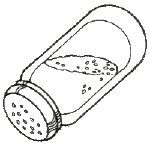
|
The following experiment along with the previous one illustrate the adverse effects of only two of the many changes that have been made in the Lake Pontchartrain Basin. As your students perform these exercises, they will develop an appreciation of just how dramatically certain environmental changes can affect our precious natural resources.

Saltwater intrusion, or the advancement of saltwater into formerly freshwater marshes and swamps, has been blamed for much of the wetland loss in the Lake Pontchartrain Basin. Quite often saltwater is allowed to enter interior marshes by way of straight canals dug by oil companies to facilitate travel during oil exploration or deepwater navigation channels designed to improve shipping traffic in the Port of New Orleans. While saltwater intrusion is not necessarily to blame for wetland loss in all parts of the Basin, it is certain that almost all plants accustomed to freshwater cannot tolerate saltwater for very long. Some plants can, over time, adapt to changing salinity conditions. Do different species react differently to changes in salinity? Can older plants tolerate greater levels of salt than young plants? How does salt affect the germination of new seedlings in fresh or intermediate marsh and swamp areas? These experiments will allow students to develop hypotheses like these concerning the effects of saltwater on various wetland plants.
- Egg cartons for planting and growing seedlings
- A bag of sterilized garden topsoil
- Some spoons
- Wetland plant seeds (these can be obtained from almost any ditch or pond, vacant lots, etc.) Try to get seeds from plants of different sizes (sedges, lilies, cypress trees, acorns, etc.). Be sure to keep the seeds separated and labeled if you know the plants. Ordinary plant seeds from your local hardware store will also demonstrate the effects of increasing salt levels.
- A plastic bottle for plant watering. Something with a sprinkler or spray top works best.
- Salt. You can use something like Instant Ocean which mimics sea water more closely, but ordinary table salt will work just fine.
- The only preparation involved is obtaining seeds, filling the egg carton sections with soil, and mixing a saltwater solution.
- Saline solutions can be tested against non-saline solutions (controls) as well as each other (increasing levels of
saltwater intrusion).
- Saltwater is measured in parts per thousand (ppt) and can easily be made up by mixing one gram of salt to 1000 ml of water for a concentration of 1 ppt. What?!? Okay, add about one teaspoon to a two-liter soft drink (bottle for a concentration of about 1 ppt...two teaspoons for 2 ppt...three teaspoons for 3 ppt...you get the idea. By the way, ocean water is roughly 35 ppt, brackish water is from 0.5 - 15 ppt, and fresh is from 0 - 0.5 ppt.
- Mix 5 ppt and 10 ppt solutions, label them clearly and set aside with the control (tap water).
- Many students will respond favorably to background information by developing their own hypotheses to test. Others may require a bit of coaxing in the right direction.
- Seedlings grown in the "control" cartons can serve as nursery stock for further experimentation that requires larger, more mature plants. For example, larger versus smaller plants, etc.
- Place ONE seed in each of the egg carton dividers. (Use the same kind of seed in each divider.)
- Place in a nice, warm, sunny place and water regularly, one tray with 0 ppt, one with 5 ppt, and one with 10 ppt. Keep the soil moist, but not wet.
- Have the students keep a log containing their DAILY observations. When seedlings sprout, they should be measured also. Observations might include such descriptions as how many leaves the plants have, when they sprouted through the soil, when they died, etc.
- The average number of seeds germinating in each of the different salinity egg cartons date can serve as data to be used for statistical analysis (t-test) to quantify the effect of salt on seedling germination.
Go back
[an error occurred while processing this directive]
|
